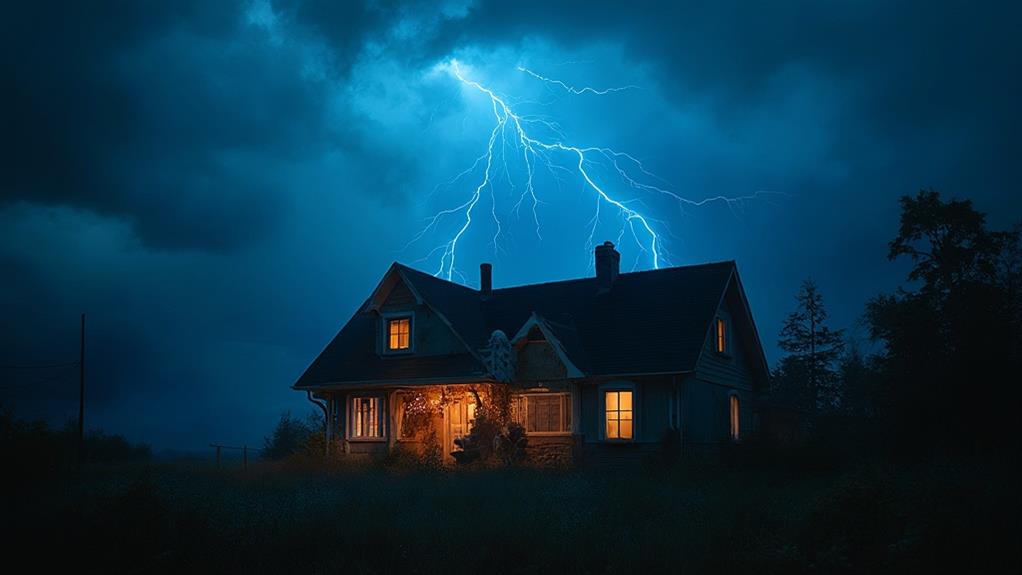Storms can unleash a variety of electrical nightmares on your home's wiring. Lightning strikes, power surges, and water infiltration pose significant risks, potentially causing fires, damaging sensitive electronics, and compromising entire electrical systems. Wind-driven debris and falling trees can sever power connections, while flooding creates dangerous shock hazards. Even indirect effects, like repeated small surges, can weaken components over time. Aging infrastructure in older homes further exacerbates these vulnerabilities. To safeguard against storm-related electrical havoc, homeowners should consider whole-house surge protection, proper grounding, and regular professional inspections. Understanding the full scope of potential dangers and preventive measures is crucial for protecting your home's electrical integrity.
Understanding Storm-Related Electrical Hazards
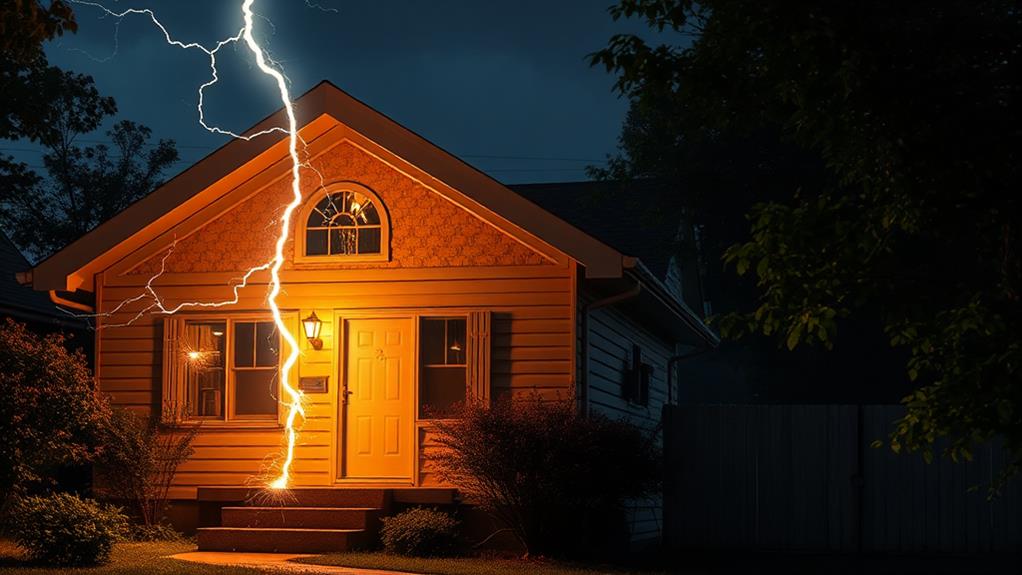
When severe storms strike, they bring with them a host of electrical hazards that can pose significant risks to your home and family. Lightning strikes, power surges, and downed power lines are among the most common threats. Lightning can directly hit your home, causing fires or damaging electrical systems. Even if it strikes nearby, it can induce voltage spikes in power lines, leading to surge damage in connected appliances and electronics.
Power surges during storms can occur when electrical systems are overloaded or when power is restored after an outage. These surges can fry sensitive components in devices and compromise your home's wiring integrity.
Downed power lines present another serious hazard, as they may still carry live current and pose electrocution risks. Water infiltration during storms can also lead to electrical issues. Moisture in walls or ceilings can cause short circuits, corrosion of wiring, and potential fire hazards. Additionally, flooding can submerge electrical outlets and appliances, creating dangerous shock risks.
Understanding these storm-related electrical hazards is crucial for homeowners to take appropriate precautions and ensure their safety during severe weather events.
Power Surges and Their Consequences
The destructive force of power surges can wreak havoc on a home's electrical system and connected devices. These sudden spikes in electrical voltage, often caused by lightning strikes or power grid fluctuations during storms, can overwhelm and damage sensitive electronic components.
Appliances, computers, and entertainment systems are particularly vulnerable to power surges, which can lead to immediate failure or gradual deterioration of their internal circuitry.
The consequences of power surges extend beyond damaged devices. They can cause electrical fires by overheating wiring and melting insulation, posing serious safety risks. Surge-related damage may not always be immediately apparent, as repeated small surges can weaken electrical components over time, leading to premature failure.
Additionally, power surges can corrupt data stored on electronic devices, resulting in loss of important information.
To mitigate these risks, homeowners should invest in whole-house surge protection systems and use point-of-use surge protectors for valuable electronics. Regular electrical inspections can help identify potential vulnerabilities in a home's wiring system.
During storms, unplugging sensitive devices and avoiding the use of major appliances can further reduce the risk of surge-related damage.
Lightning Strikes: Direct and Indirect
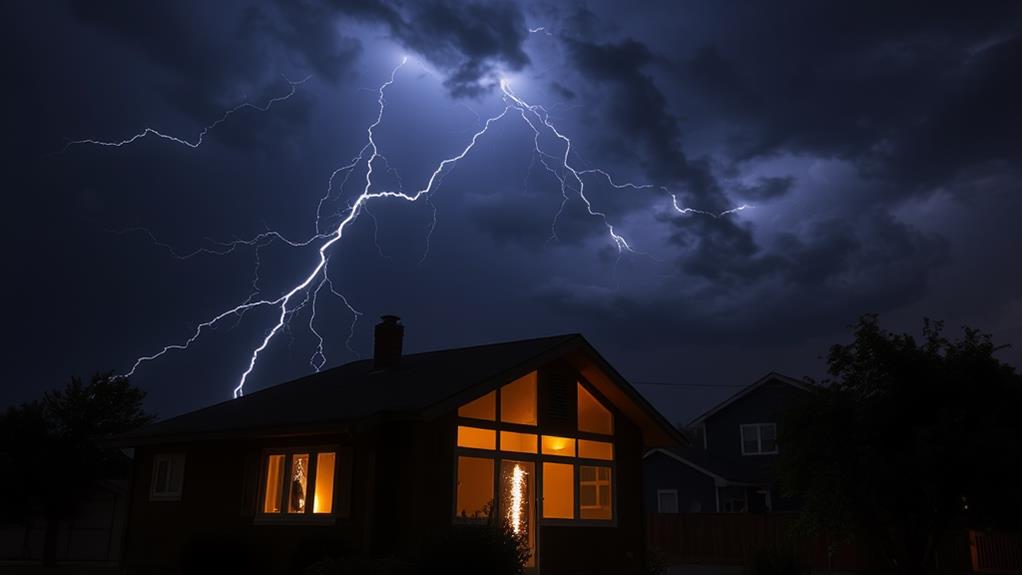
Among the most severe electrical threats during storms, lightning strikes pose a significant danger to residential electrical systems. These strikes can be categorized into two types: direct and indirect.
Direct strikes occur when lightning directly hits a house or its immediate surroundings, causing instantaneous and catastrophic damage to the electrical system. The immense electrical current can melt wires, destroy appliances, and potentially start fires.
Indirect strikes, while less destructive, are more common and still pose considerable risks. These occur when lightning strikes nearby, inducing electrical surges through power lines, phone lines, or even the ground. The resulting voltage spikes can damage sensitive electronics and overwhelm surge protectors. Indirect strikes can also cause cumulative damage over time, weakening electrical components and increasing the likelihood of future failures.
To mitigate the risks associated with both direct and indirect lightning strikes, homeowners should consider installing a comprehensive lightning protection system. This typically includes lightning rods, grounding electrodes, and surge protection devices. Regular maintenance of these systems, along with proper grounding of all electrical equipment, can significantly reduce the potential for lightning-related damage to a home's electrical infrastructure.
Water Damage to Electrical Systems
Flooding and water infiltration during severe storms present significant hazards to residential electrical systems. Water can corrode wiring, short-circuit components, and compromise the integrity of electrical panels. Even after floodwaters recede, residual moisture can lead to long-term damage and safety risks.
When water enters electrical outlets, switches, or junction boxes, it can cause immediate short circuits and potentially start fires. Corrosion of copper wires and metal components accelerates in the presence of moisture, weakening connections and increasing electrical resistance. This can lead to overheating and system failures.
Waterlogged insulation materials surrounding wires may lose their protective properties, increasing the risk of electrical shock. Additionally, water damage to GFCI outlets can render them ineffective, eliminating a crucial safety feature.
The electrical panel, often located in basements or lower levels of homes, is particularly vulnerable to flooding. Water intrusion can damage circuit breakers, corrode bus bars, and compromise the panel's ability to safely distribute power throughout the house.
To mitigate these risks, homeowners should immediately shut off power to affected areas, have a licensed electrician inspect the system, and replace damaged components before restoring power.
Wind-Induced Wiring Problems
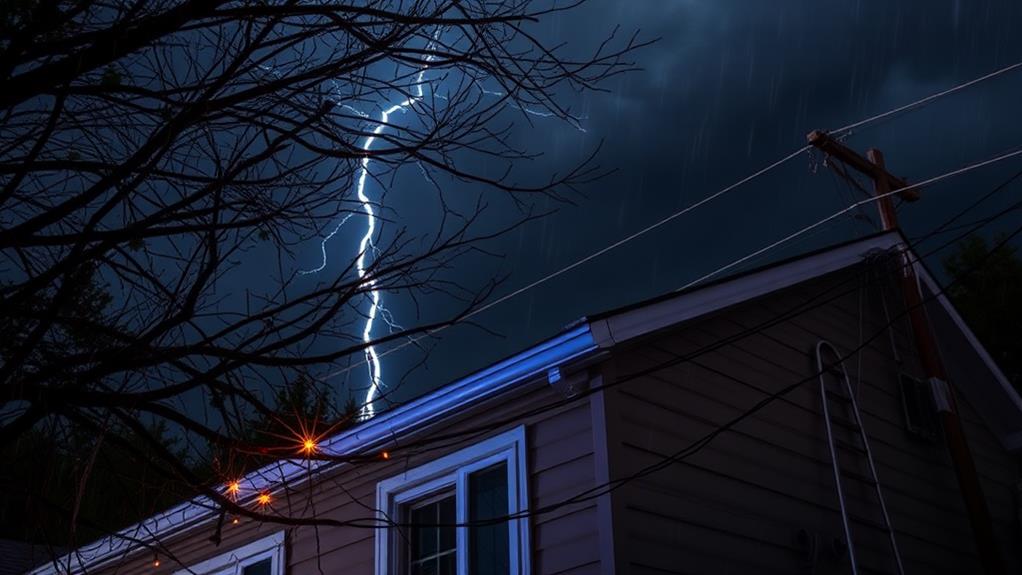
Strong winds associated with severe storms can cause three primary types of damage to residential electrical systems. First, wind-blown debris can strike and damage external components such as power lines, transformers, and meter boxes. This may lead to power outages or compromised connections.
Second, high winds can cause trees or large branches to fall onto power lines, potentially severing connections or creating dangerous electrical hazards.
The third type of wind-induced wiring problem occurs when sustained gusts infiltrate the home's structure. This can loosen or disconnect internal wiring, especially in older homes with outdated electrical systems. Wind-driven rain may also penetrate walls, ceilings, or roofs, leading to moisture accumulation around electrical outlets, switches, or junction boxes.
To mitigate these risks, homeowners should regularly inspect their property for potential hazards, such as overhanging tree limbs or loose exterior components. Installing surge protectors and maintaining a well-grounded electrical system can also help safeguard against wind-related electrical issues. After severe storms, it's crucial to have a licensed electrician inspect the home's wiring for any hidden damage or potential safety concerns before fully restoring power.
Aging Infrastructure and Storm Vulnerability
While wind-related damage poses significant risks to electrical systems, the age and condition of a home's infrastructure play a key role in its vulnerability to storm-induced electrical problems. Older homes often have outdated wiring systems that may not meet current safety standards, making them more susceptible to damage during severe weather events.
Aging electrical components, such as frayed wires, corroded connections, and deteriorating insulation, can exacerbate the impact of storms on a home's electrical system. These weakened elements are more likely to fail when subjected to power surges, lightning strikes, or water infiltration. Additionally, older homes may lack modern protective measures like whole-house surge protectors or advanced grounding systems, leaving them more exposed to electrical disturbances.
The combination of aging infrastructure and severe weather can lead to a range of issues, including short circuits, electrical fires, and equipment damage. To mitigate these risks, homeowners should consider having their electrical systems inspected and upgraded by licensed professionals. This may involve replacing outdated wiring, installing protective devices, and ensuring proper grounding. Regular maintenance and timely repairs can significantly enhance a home's resilience to storm-related electrical problems, safeguarding both property and occupants.
Hidden Damage Assessment Techniques
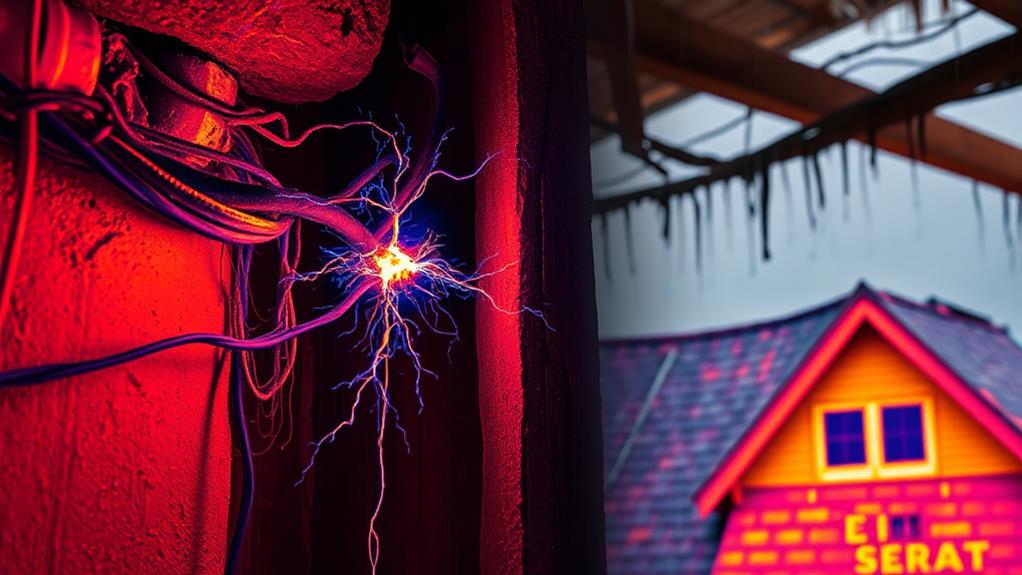
Detecting hidden electrical damage in the aftermath of a storm requires specialized techniques and expertise. Professional electricians employ a range of methods to uncover potential hazards that may not be immediately visible.
Thermal imaging cameras are used to identify hot spots in walls and ceilings, indicating overloaded circuits or damaged wiring. These devices can detect temperature variations that suggest electrical issues before they become more severe.
Another crucial technique is circuit analysis, which involves testing individual circuits to ensure proper functioning and identify any irregularities. Electricians use multimeters to measure voltage, current, and resistance, helping to pinpoint areas of concern. Ground fault circuit interrupter (GFCI) testers are employed to verify the functionality of these important safety devices, which are particularly vulnerable to storm damage.
Visual inspections remain essential, with professionals examining visible wiring, outlets, and electrical panels for signs of water damage, corrosion, or burning. In some cases, small cameras may be used to inspect hard-to-reach areas within walls or ceilings. Ultrasonic testing can detect arcing or partial discharge in concealed wiring, providing early warning of potential fire hazards.
Preventive Measures for Homeowners
Savvy homeowners can take several proactive steps to protect their electrical systems from storm-related damage. Installing a whole-house surge protector is a crucial first line of defense, diverting excess voltage away from sensitive electronics and appliances.
Regularly inspecting and maintaining electrical panels, ensuring they are free from corrosion and properly sealed, can prevent water ingress during storms.
Grounding rods should be checked and replaced if necessary, as they play a vital role in redirecting lightning strikes safely into the ground. Trimming trees near power lines can reduce the risk of falling branches damaging electrical infrastructure. Additionally, installing lightning rods on the roof can provide added protection for homes in lightning-prone areas.
Homeowners should also consider investing in a backup generator to maintain power during outages, protecting sensitive equipment from sudden shutdowns and power surges when electricity is restored. Regularly updating and replacing outdated wiring can significantly improve a home's resilience to storm-related electrical issues. Finally, creating an emergency plan that includes shutting off main power switches during severe weather events can prevent potential electrical fires and equipment damage.
Professional Inspection and Repairs
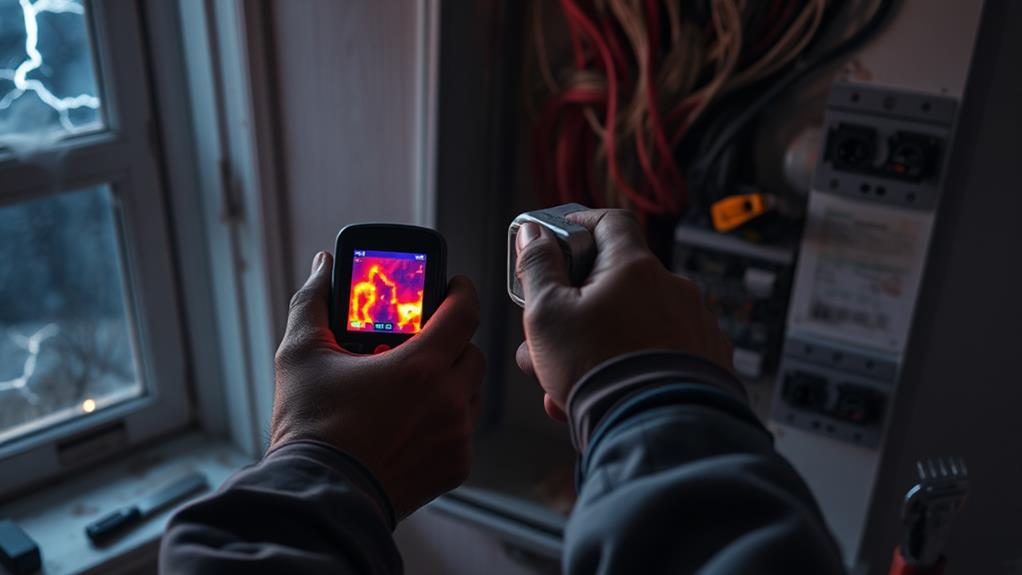
Despite homeowners' best efforts, some electrical issues require professional expertise. After severe storms, it's crucial to have a licensed electrician inspect your home's electrical system for hidden damage. These professionals can identify and address problems that may not be immediately apparent, such as loose connections, damaged wiring, or compromised insulation.
During an inspection, electricians will thoroughly examine your home's electrical panel, outlets, switches, and wiring. They'll check for signs of water damage, corrosion, or overheating, which can indicate storm-related issues. Advanced diagnostic tools, such as thermal imaging cameras, may be used to detect hot spots or abnormalities in the electrical system.
If repairs are necessary, professional electricians have the skills and equipment to safely address the problems. This may involve replacing damaged components, rewiring sections of the home, or upgrading outdated systems to improve safety and efficiency. In some cases, they may recommend installing surge protectors or other protective devices to mitigate future storm-related damage.
Regular professional inspections, especially after severe weather events, can help prevent electrical fires, equipment damage, and potential injuries. Investing in expert assessments and repairs ensures your home's electrical system remains safe and reliable.
Insurance Considerations for Electrical Damage
Homeowners often overlook the importance of insurance coverage for electrical damage caused by storms. Standard homeowners insurance policies typically cover electrical damage resulting from lightning strikes or power surges, but the extent of coverage can vary. It's crucial to review your policy carefully and understand what is and isn't covered.
Some policies may have limitations on coverage for electrical systems or appliances damaged by power surges. Others might exclude coverage for gradual deterioration or wear and tear of electrical components. To ensure comprehensive protection, consider adding specific endorsements or riders to your policy that address electrical damage.
Many insurers offer equipment breakdown coverage, which can protect against sudden electrical failures. This add-on can be particularly valuable for homes with expensive electrical systems or smart home technology. Additionally, some companies provide surge protection endorsements that cover damage from external power surges.
When filing a claim for electrical damage, document the incident thoroughly, including photos and receipts for repairs. Be prepared to demonstrate that the damage was caused by a covered peril, such as a storm, rather than pre-existing issues or poor maintenance.
Frequently Asked Questions
Can a Storm Cause Electrical Fires Even Days After It Has Passed?
Yes, storms can potentially cause electrical fires days after passing. Lingering moisture, damaged wiring, or compromised insulation may lead to short circuits or overheating. Regular inspections and prompt repairs are crucial to mitigate these delayed risks.
How Often Should I Have My Home's Electrical System Professionally Inspected?
Like a regular health check-up, your home's electrical system needs periodic attention. Experts recommend professional inspections every 3-5 years for older homes and every 10 years for newer ones. However, immediate inspections are advisable after major renovations or electrical issues.
Are Smart Home Devices More Vulnerable to Storm-Related Electrical Damage?
Smart home devices can indeed be more susceptible to storm-related electrical damage. Their sensitive electronic components and constant connectivity make them vulnerable to power surges and fluctuations. Implementing surge protection and proper grounding can help mitigate these risks.
Can Electrical Damage From Storms Affect My Wi-Fi and Internet Connectivity?
Picture this: Your Wi-Fi router, once a beacon of connectivity, now a storm-battered casualty. Indeed, electrical surges from storms can damage networking equipment, disrupting your internet connection. Protect your digital lifeline with surge protectors and consider battery backups.
Do Solar Panel Systems Provide Protection Against Storm-Related Electrical Issues?
Solar panel systems do not inherently provide protection against storm-related electrical issues. While they can offer an alternative power source during outages, they require proper surge protection and grounding to safeguard against lightning strikes and power surges.
Conclusion
Storms, nature's electrical spectacles, illuminate the sky while casting shadows of danger on homes. As thunder fades, unseen threats linger in walls and circuits. The juxtaposition of awe-inspiring lightning and potentially devastating consequences underscores the critical need for vigilance. Through preventive measures, professional assessments, and adequate insurance coverage, homeowners can weather these electrical nightmares. In the aftermath of nature's fury, a proactive approach ensures that the light of safety continues to shine within storm-tested dwellings.
